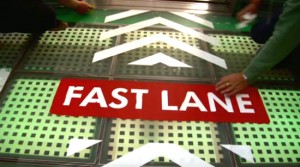A few months ago I was asked to be a guest blogger for Imageworks. I’ve known and worked closely with this team of talented individuals for five years now. They asked to me to discuss any topic that folks might find interesting about marketing, so I decided to write about the concept of “less is more.” A concept that is missed by many, but for those who realize ad space isn’t a dumping ground for bad copy and cheap sales pitches, can be an emotional and powerful brand builder.
Here’s the link to my original post: Let Whitespace Tell the Story.
Or…read it here:
Geoff Peddicord works for Missoula’s Community Medical Center, a favorite client of ours. Officially, he’s the Director of Marketing & Public Relations. Unofficially, he’s just really great at what he does and what he does is connect people with brand. Here, Geoff shares the moment of inspiration behind a very successful marketing campaign.
Letting go and letting the whitespace tell the story
We all have those defining moments in our professional world when we read or see something that puts everything we do into perspective. It may be a quote by the original madman David Ogilvy. Perhaps it’s re-reading Theodore Levitt’s flash of genius in his groundbreaking whitepaper, “Marketing Myopia.”
Oddly enough, I found a fresh perspective by reaching deep into the past. Antoine de Saint Exupery was a French aviator alive in the early 1900’s. He flew airplanes and was a poet and literary master. He understood the most basic principles of aeronautic design, what makes something fly. It is his paragraph about shaping the wing of an airplane that rattled my foundation and forever changed the way I go about building a marketing campaign and driving a brand.
“Have you ever thought, not only about the airplane but about whatever man builds, that all of man’s industrial efforts, all his computations and calculations, all the nights spent over working draughts and blueprints, invariably culminate in the production of a thing whose sole and guiding principle is the ultimate principle of simplicity? A designer knows he has achieved perfection not when there is nothing left to add, but when there is nothing left to take away.” – Antoine de Saint Exupery (1939).
So many times we get caught up in thinking we have to hand deliver our story to the audience with a silver spoon. We find ourselves speaking to the lowest common denominator, slaving away on copy trying to convey every possible aspect of our service, product or offering. It’s almost as if we have some strange drive, that if we are purchasing 9.89 columns X 7.00 inches of print space, then by God, we are going fill that entire area with words, pictures and design elements.
Personally, I’ve grown tired of marketing to the lowest common denominator. I refuse to fill whitespace with useless graphics and unnecessary words. I’ve started trusting that our audience is intelligent and can think for themselves. Know that they have the ability to look at the work, find their own story in the whitespace, and take themselves to this space I’m asking them to go. I don’t need overdesigned pieces, tons of copy and huge logos. It’s all unnecessary. The imagination of the audience is a powerful tool when effectively prompted.
Is this an easy task? Is embracing the whitespace something that the C-Suite corporate suits will stand behind? Probably not right away. But I promise you that fighting for that whitespace will pay dividends.
Audi doesn’t tell us how they make steering wheels or what kind of gas pedals they use. All they want to do is convey the way we will feel when driving their cars. Patagonia became a brand leviathan because they showed their garments being used by real people, in the real world. They added nothing else to the photos. No fancy copy, no quirky headers or tag lines. Patagonia sells a lifestyle and produces the best quality outdoor clothing in the industry. They don’t need to tell people that. Customers figured it out for themselves and today they are still the brand to beat in the outdoor industry.
And what about that C-suit executive who fancy themselves as marketing experts? How do you respond to the inevitable “I want to see the logo bigger” discussion? This is likely your best retort.
You have to be able to explain to them that subtlety goes much further in the mind of the consumer. Big logos in marketing are the equivalent of shouting and we never shout. Confident organizations that trust themselves understand that you don’t need a huge logo on a marketing piece to make a point and we all know that people relate to people, not logos. If your brand is consistent across the board the audience will ultimately recognize the campaign as yours regardless of the size of your logo.
Taking Exupery’s advice, we strip away the unnecessary elements, build power with fewer words and ultimately have faith that in that whitespace, in those areas of the undefined, that is where the audience finds their own story and creates that pure connection to your brand.








